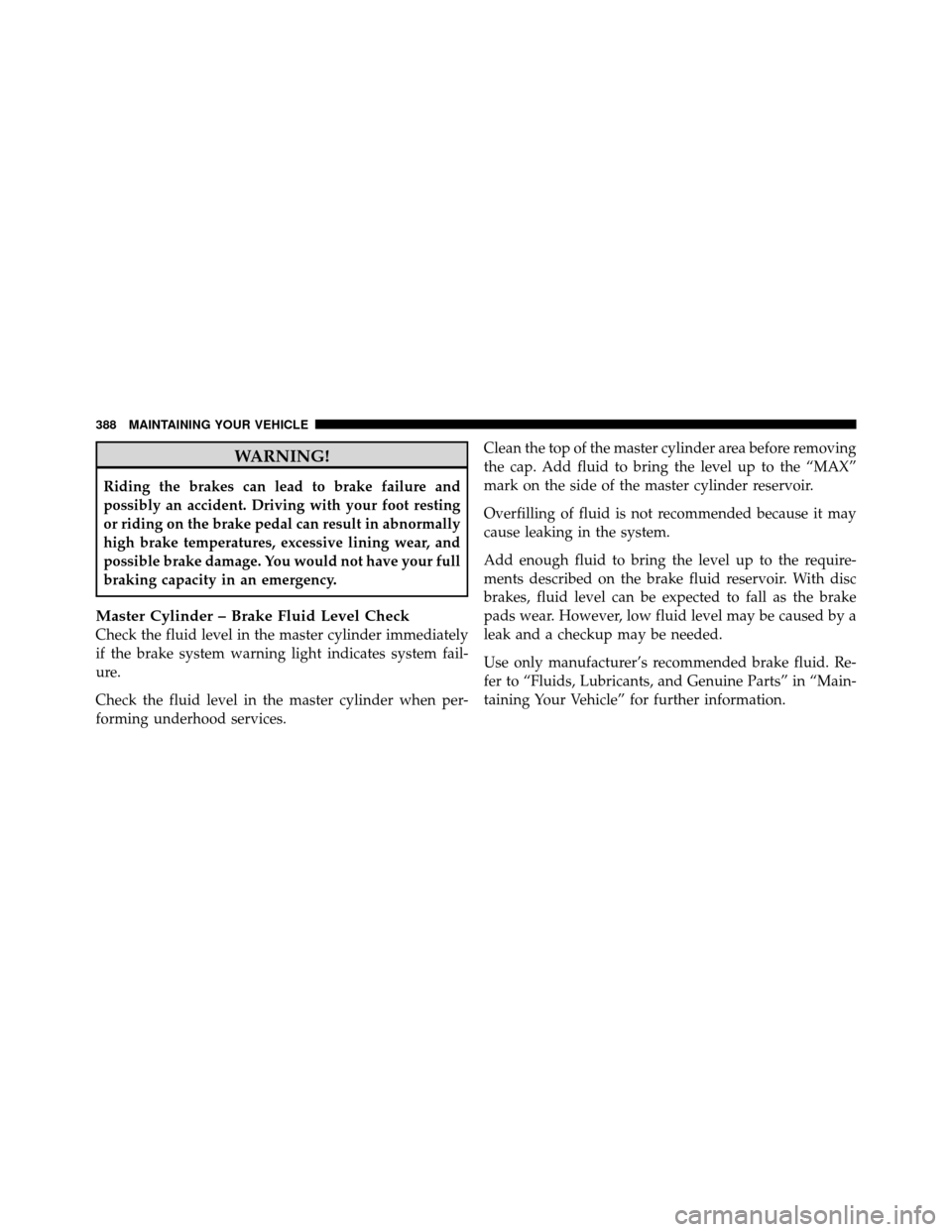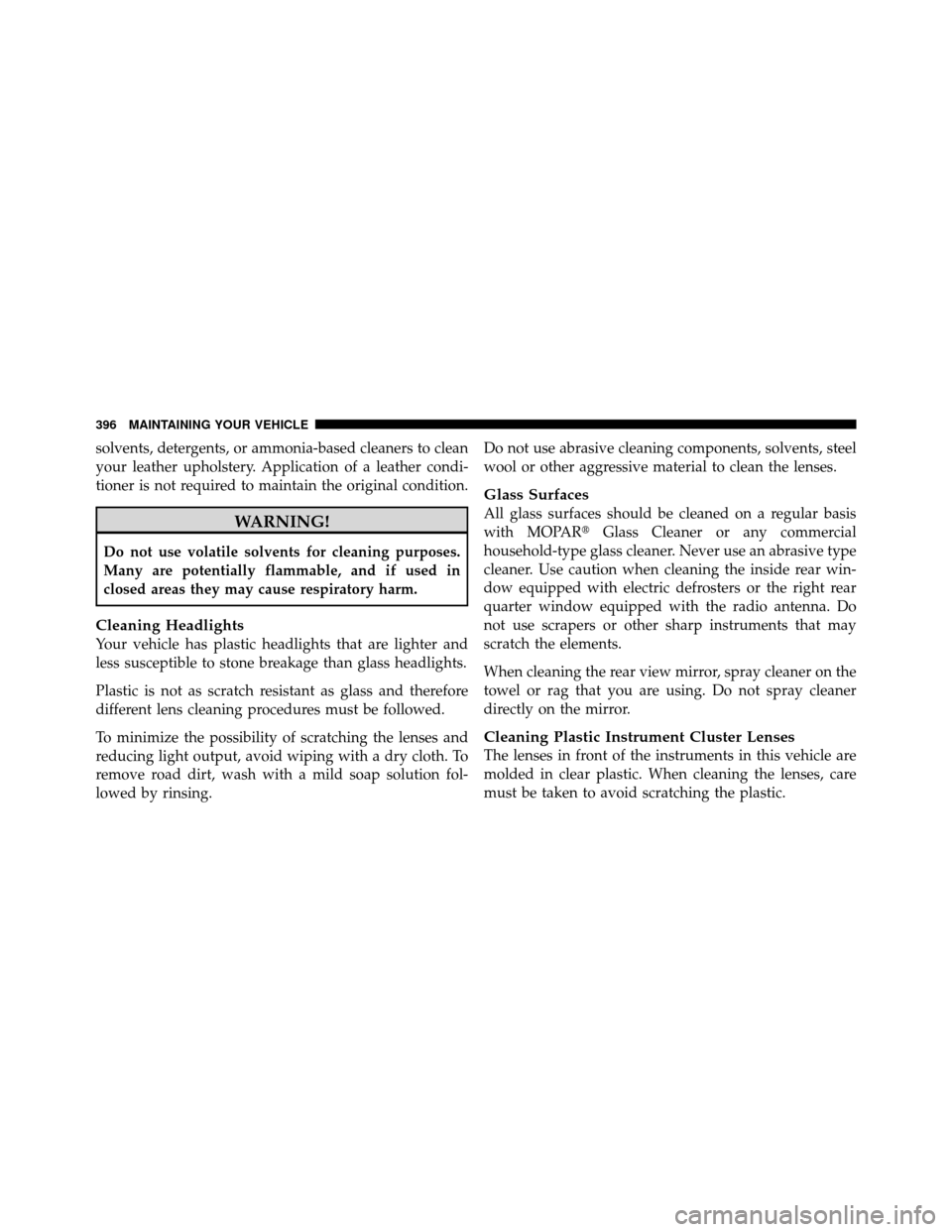Page 368 of 465

TRIP ODOMETER button to turn off the message. If the
problem continues, the message will appear the next time
the vehicle is started.
A loose, improperly installed, or damaged fuel filler cap
may also turn on the MIL.
EMISSIONS INSPECTION AND MAINTENANCE
PROGRAMS
In some localities, it may be a legal requirement to pass
an inspection of your vehicle’s emissions control system.
Failure to pass could prevent vehicle registration.For states that require an Inspection and Mainte-
nance (I/M), this check verifies the “Malfunction
Indicator Light (MIL)” is functioning and is not
on when the engine is running, and that the OBD II
system is ready for testing.
Normally, the OBD II system will be ready. The OBD II
system may notbe ready if your vehicle was recently serviced, recently had a dead battery or a battery replace-
ment. If the OBD II system should be determined not
ready for the I/M test, your vehicle may fail the test.
Your vehicle has a simple ignition key-actuated test,
which you can use prior to going to the test station. To
check if your vehicle’s OBD II system is ready, you must
do the following:
1. Turn the ignition switch to the ON position, but do not
crank or start the engine.
2. If you crank or start the engine, you will have to start
this test over.
3. As soon as you turn the ignition switch to the ON
position, you will see the MIL symbol come on as part of
a normal bulb check.
4. Approximately 15 seconds later, one of two things will
happen:
7
MAINTAINING YOUR VEHICLE 367
Page 389 of 465

WARNING!
Riding the brakes can lead to brake failure and
possibly an accident. Driving with your foot resting
or riding on the brake pedal can result in abnormally
high brake temperatures, excessive lining wear, and
possible brake damage. You would not have your full
braking capacity in an emergency.
Master Cylinder – Brake Fluid Level Check
Check the fluid level in the master cylinder immediately
if the brake system warning light indicates system fail-
ure.
Check the fluid level in the master cylinder when per-
forming underhood services.Clean the top of the master cylinder area before removing
the cap. Add fluid to bring the level up to the “MAX”
mark on the side of the master cylinder reservoir.
Overfilling of fluid is not recommended because it may
cause leaking in the system.
Add enough fluid to bring the level up to the require-
ments described on the brake fluid reservoir. With disc
brakes, fluid level can be expected to fall as the brake
pads wear. However, low fluid level may be caused by a
leak and a checkup may be needed.
Use only manufacturer’s recommended brake fluid. Re-
fer to “Fluids, Lubricants, and Genuine Parts” in “Main-
taining Your Vehicle” for further information.
388 MAINTAINING YOUR VEHICLE
Page 397 of 465

solvents, detergents, or ammonia-based cleaners to clean
your leather upholstery. Application of a leather condi-
tioner is not required to maintain the original condition.
WARNING!
Do not use volatile solvents for cleaning purposes.
Many are potentially flammable, and if used in
closed areas they may cause respiratory harm.
Cleaning Headlights
Your vehicle has plastic headlights that are lighter and
less susceptible to stone breakage than glass headlights.
Plastic is not as scratch resistant as glass and therefore
different lens cleaning procedures must be followed.
To minimize the possibility of scratching the lenses and
reducing light output, avoid wiping with a dry cloth. To
remove road dirt, wash with a mild soap solution fol-
lowed by rinsing.Do not use abrasive cleaning components, solvents, steel
wool or other aggressive material to clean the lenses.
Glass Surfaces
All glass surfaces should be cleaned on a regular basis
with MOPAR�
Glass Cleaner or any commercial
household-type glass cleaner. Never use an abrasive type
cleaner. Use caution when cleaning the inside rear win-
dow equipped with electric defrosters or the right rear
quarter window equipped with the radio antenna. Do
not use scrapers or other sharp instruments that may
scratch the elements.
When cleaning the rear view mirror, spray cleaner on the
towel or rag that you are using. Do not spray cleaner
directly on the mirror.
Cleaning Plastic Instrument Cluster Lenses
The lenses in front of the instruments in this vehicle are
molded in clear plastic. When cleaning the lenses, care
must be taken to avoid scratching the plastic.
396 MAINTAINING YOUR VEHICLE
Page 404 of 465
Cavity Car-tridge
FuseMini-
Fuse
Description
12 * ———
13 * ———
14 — 10 Amp RedAC Heater Control/
Cluster/Security Mod-
ule – If Equipped
15———
16———
17 — 20 Amp YellowCluster
18 — 20 Amp YellowSelectable Power Outlet
19 — 10 Amp RedStop Lights
20———
21———Cavity Car- tridge
FuseMini-
Fuse
Description
22———
23———
24———
25———
26———
27 — 10 Amp RedOccupant Restraint Con-
troller (ORC)
28 — 10 Amp RedIgnition Run
29 — 5 Amp OrangeCluster/Electronic Sta-
bility Program (ESP)/
Powertrain Control
Module (PCM)/Stop
Light Switch
7
MAINTAINING YOUR VEHICLE 403
Page 405 of 465
Cavity Car-tridge
FuseMini-
Fuse
Description
30 — 10 Amp RedDoor Modules/Power
Mirrors/Steering Con-
trol Module (SCM)
31———
32———
33———
34———
35 — 5 Amp OrangeAntenna Module – If
Equipped/Power Mir-
rors
36 — 25 Amp NaturalHands-Free Phone – If
Equipped/Video Moni-
tor – If Equipped/Radio
37 — 15 Amp BlueTransmissionCavity Car-
tridge
FuseMini-
Fuse
Description
38 — 10 Amp RedCargo Light/Satellite
Receiver (SDARS) Video
– If Equipped/Vehicle
Information Module – If
Equipped
39 — 10 Amp RedHeated Mirrors – If
Equipped
40 — 5 Amp OrangeAuto Inside Rearview
Mirror/Heated Seats – If
Equipped/Switch Bank
41———
42 30 Amp Pink— Front Blower Motor
43 30 Amp Pink— Rear Window Defroster
404 MAINTAINING YOUR VEHICLE
Page 407 of 465

REPLACEMENT BULBS
LIGHT BULBS – InteriorBulb Number
Rear Courtesy/Reading Lamps ............. W5W
Rear Compartment (Trunk) Lamp ............. 562
Overhead Console Reading Lamps ............ 578
Visor Vanity Lamps ..................... A6220
Glove Box Lamp – If Equipped ............... 194
Door Courtesy .......................... 562
Shift Indicator Lamp ................. JKLE14140
Optional Door Map Pocket/
Cupholder .... LED (Serviced at Authorized Dealer)
NOTE: For lighted switches, see your authorized dealer
for replacement instructions.
All of the interior bulbs are glass wedge base or glass
cartridge types. Aluminum base bulbs are not approved
and should not be used for replacement. LIGHT BULBS – Exterior
Bulb Number
Low Beam Headlamp – High Intensity Discharge
(HID) .......... D1S (Serviced at Authorized Dealer)
High Beam Headlamp .................... 9005
Front Park/Turn Lamp .................3157AK
Front Fog Lamp ...................... PSX24W
Front Side
Marker ........ W5W (Serviced at Authorized Dealer)
Tail/Stop Lamp ......................... 3057
Tail Lamp ............................. 3057
Turn Signal Lamp ...................... 3757A
Backup Lamp .......................... 3057
Center High Mount Stop Lamp (CHMSL) ....... LED
License .............................. W5W
406 MAINTAINING YOUR VEHICLE
Page 408 of 465
BULB REPLACEMENT
Low Beam Headlamp, High Beam Headlamp, and
Park/Turn Lamp
High Intensity Discharge Headlamps (HID)
The headlamps are a type of high voltage discharge tube.
High voltage can remain in the circuit even with the
headlight switch off and the key removed.Because of
this, you should not attempt to service a headlamp bulb
yourself. If a headlamp bulb fails, take your vehicle to
an authorized dealer for service.
NOTE: When HID headlamps are turned on, there is a
blue hue to the lamps. This diminishes and becomes
more white after approximately 10 seconds, as the system
charges.
Tail/Stop, Tail, Turn Signal Lamp, and Backup
Lamp
1. Open the trunk. 2. Remove the two fasteners from the back of the tail
lamp assembly.
3. Pull back the trunk liner.
4. Remove the remaining fastener from the back of the
tail lamp assembly.
5. Push the electrical connector locking tab to the side.
7
MAINTAINING YOUR VEHICLE 407
Page 419 of 465
•Check the fluid levels of the coolant reservoir, brake
master cylinder, and power steering, add as needed.
•Check all lights and other electrical items for correct
operation.
At Each Oil Change
•Change the engine oil filter.
•Inspect the brake hoses and lines.
CAUTION!
Failure to perform the required maintenance items
may result in damage to the vehicle.
Required Maintenance Intervals
Refer to the Maintenance Schedules on the following
pages for the required maintenance intervals.
8
M A I
N T
E
N A
N CE
S
C
H E
D
U L
E
S418 MAINTENANCE SCHEDULES